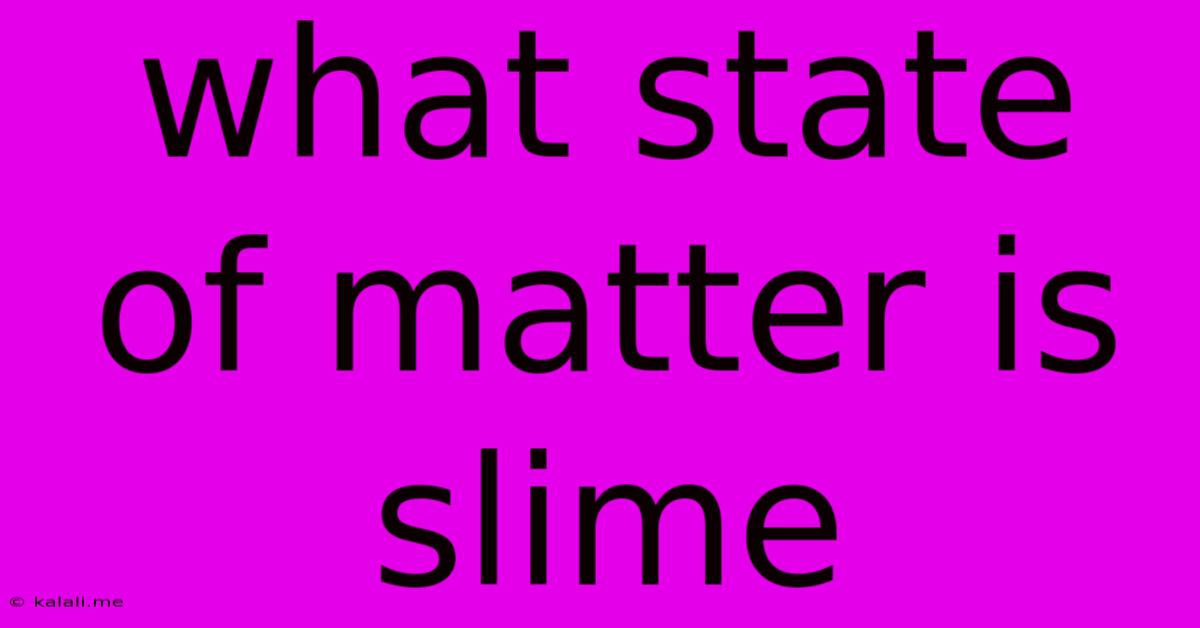What State Of Matter Is Slime
Kalali
May 10, 2025 · 3 min read

Table of Contents
What State of Matter is Slime? A Surprisingly Complex Question
Slime. That gooey, stretchy, satisfying substance that's captivated children (and adults!) for generations. But have you ever stopped to consider its fundamental nature? What state of matter is it, exactly? It's not as simple as you might think! This article delves into the surprisingly complex answer, exploring the properties of slime and how they defy easy categorization. Understanding the scientific classification of slime helps appreciate its unique properties and the fascinating science behind it.
While often referred to as a "liquid," slime's behavior is far more nuanced than that of a simple liquid like water. It exhibits characteristics of several states of matter, blurring the lines of traditional classifications. This makes its classification a topic of ongoing discussion and exploration in materials science.
Beyond Solid, Liquid, and Gas: Understanding Non-Newtonian Fluids
The most accurate classification of slime is as a non-Newtonian fluid. This means its viscosity (resistance to flow) changes depending on the applied force or stress. Unlike Newtonian fluids (like water), which have a constant viscosity regardless of the force applied, non-Newtonian fluids can behave in various ways.
- Shear-thinning: When a force is applied, slime becomes less viscous, flowing more easily. This is why you can easily pour slime, but it resists stretching or pulling. Think of poking it – it will flow under pressure.
- Shear-thickening: In contrast to shear-thinning, some slimes exhibit shear-thickening behavior. This means they become more viscous under stress. A sudden, strong force (like punching it) causes it to temporarily solidify.
- Viscoelasticity: Slime also displays viscoelastic properties, meaning it exhibits both viscous (liquid-like) and elastic (solid-like) characteristics. This explains its ability to stretch and return to its original shape (to some extent), a behavior not found in typical liquids.
The Chemistry of Slime: Understanding its Composition
The specific behavior of slime hinges heavily on its composition. Homemade slime recipes often use a combination of:
- Polyvinyl alcohol (PVA): This polymer is a key ingredient in many slime recipes, providing the stretchy, elastic properties.
- Borax: This acts as a cross-linking agent, connecting the PVA chains to create a more solid-like structure.
- Other additives: Many variations exist, incorporating ingredients like glue, liquid starch, contact lens solution, or even shaving cream, each influencing the final texture and properties of the slime.
The precise ratio of these ingredients and the addition of other substances can significantly change the resulting slime’s characteristics, leading to variations in its viscosity and elasticity.
The Ongoing Debate: Classifying Slime
Because slime exhibits characteristics of both liquids and solids (and more!), definitively categorizing it remains a subject of discussion. It doesn't neatly fit into the traditional solid, liquid, gas, or plasma classifications. Instead, its non-Newtonian behavior and viscoelastic properties highlight the complexity and diversity of materials in the world.
It is better to think of slime not as belonging to a single state of matter, but as existing in a fascinating interplay of states, a testament to the richness and unexpected behavior of materials science. Understanding this complexity makes the seemingly simple substance of slime all the more intriguing.
Latest Posts
Latest Posts
-
How Far Is 0 4 Miles To Walk
Jul 12, 2025
-
What Is 20 Percent Of 800 000
Jul 12, 2025
-
Words That Start With Y In Science
Jul 12, 2025
-
Prevent An Expressway Emergency By Merging Without
Jul 12, 2025
-
How Many Grams Of Sugar In A Pound
Jul 12, 2025
Related Post
Thank you for visiting our website which covers about What State Of Matter Is Slime . We hope the information provided has been useful to you. Feel free to contact us if you have any questions or need further assistance. See you next time and don't miss to bookmark.